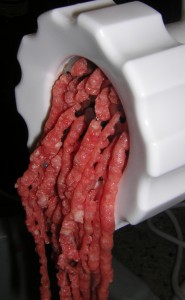Cattle in Michigan have been electronically tagged and tracked since 2010 in a bid to control bovine tuberculosis.
According to NPR, whenever a steer or cow leaves a farm in Michigan, or goes to a slaughterhouse, it passes by a tag reader, and its ID number goes to a central computer that keeps track of every animal’s location.
If an animal is discovered to be sick, “we can track that animal all the way back, through every herd that it’s been in, through any sale yard it’s been  through, back to the farm of origin,” said Steve Halstead, Michigan’s state veterinarian.
through, back to the farm of origin,” said Steve Halstead, Michigan’s state veterinarian.
“There’s a large number of people that would like to know where their food comes from, just understand that better,” says Daniel Buskirk, an expert on the beef industry at Michigan State University.
He’s using the university’s own herd of cattle to experiment with ways to track those animals and then make information about them available to shoppers in the store.
“This is one way that we can hopefully kind of connect the story of how this food is being produced with the consumers who are consuming it,” Buskirk says.
Last year, when 72 of the university’s steers went to the slaughterhouse, Buskirk set up a system that transferred the identity of each animal from its electronic ID tag to a new set of tags — little square bar codes.
Those bar codes were pinned to the carcass. And as butchers went to work on it, cutting it into smaller pieces, they used a little handheld device to scan that first bar code and print new ones for each new cut of meat. In this case, the meat just went to the university’s food service, not a grocery store.
But the same system eventually could produce a label that would go on a package of meat in the store. “Then if you have a smartphone,” Buskirk says, “I can scan that two-dimensional bar code, and it will give information about the origin of that beef.”
In the case of the meat that went to Michigan’s food service, it showed an aerial picture of the farm. But in theory, the label could link to any  information at all. It could tell consumers “what goes on at the farm, how the animals might be cared for, how they might be fed,” Buskirk says.
information at all. It could tell consumers “what goes on at the farm, how the animals might be cared for, how they might be fed,” Buskirk says.
Even better, microbial food safety data and interventions used to reduce the risk of dangerous pathogens.
Technology is also changing the business of restaurant inspection disclosure
Government Technology reports that a new national open data standard, called the Local Inspector Value-Entry Specification, was created. To enable any city to voluntarily share restaurant inspection scores on Yelp or other websites to make that data more transparent.
On the mobile app front, Sacramento County, Calif., and other municipalities are releasing smartphone apps that will make looking up inspection scores easier.
Launched in late 2011, the Sacramento County Food Facilities Inspections app shows a person’s current location in the county and nearby retail food facilities, which are marked on a map and on a list. The color of the markers on the map indicate the most recent food inspection result, inspection date and links to more detailed information.
Food inspection data refreshes daily and is complete for all food facilities in the county, including restaurants, bars, grocery stories, convenience stores, school cafeterias and most facilities that dispense food to the public.
 Nicole Johnson-Hoffman, Cargill’s vice president and managing director of Cargill’s North American McDonald’s business, discussed the forthcoming product line at the Global Conference for Sustainable Beef, held here this week.
Nicole Johnson-Hoffman, Cargill’s vice president and managing director of Cargill’s North American McDonald’s business, discussed the forthcoming product line at the Global Conference for Sustainable Beef, held here this week.







